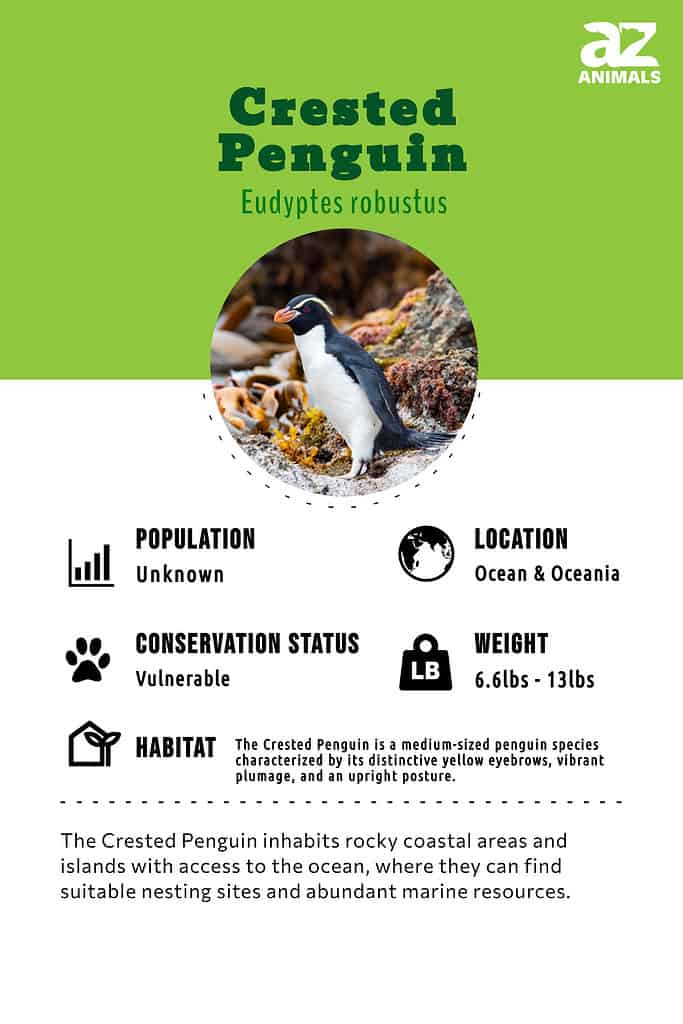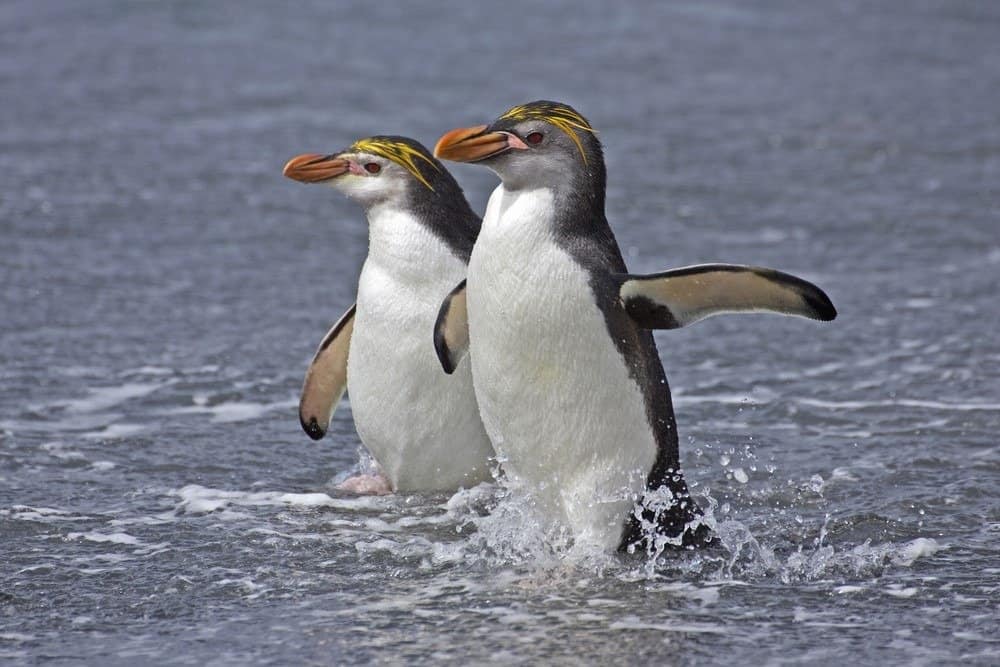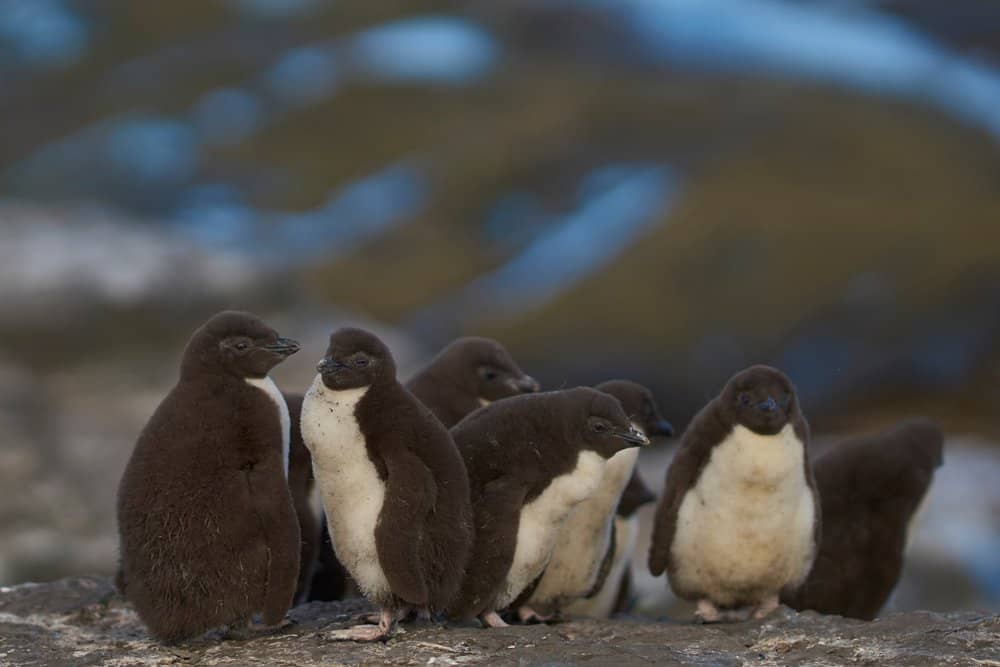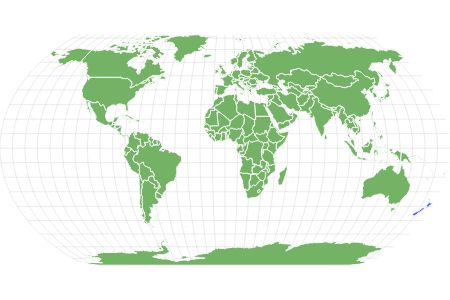Crested Penguin
Eudyptes robustus
Has long yellow eyebrows!
Advertisement
Crested Penguin Scientific Classification
- Kingdom
- Animalia
- Phylum
- Chordata
- Class
- Aves
- Order
- Sphenisciformes
- Family
- Spheniscidae
- Genus
- Eudyptes
- Scientific Name
- Eudyptes robustus
Read our Complete Guide to Classification of Animals.
Crested Penguin Conservation Status
Crested Penguin Facts
- Main Prey
- Krill, Fish, Shrimp
- Distinctive Feature
- Red beak and bright yellow eyebrows
- Habitat
- Rocky Antarctic Islands
- Predators
- Leopard Seal, Killer Whale, Sharks
- Diet
- Carnivore
View all of the Crested Penguin images!

The crested penguin has long yellow eyebrows.
It lives in the watery areas off of a rocky Antarctic island named Snare Island, where it eats krill and other tastes. This penguin is one of six different species that live in the general area. The crested penguin is grey, yellow, black, and white. It lives as much as 20 years in the wild.
Incredible Crested Penguin Facts!

The penguin consumes krill, juvenile squid, and various other aquatic organisms as part of its diet.
©iStock.com/Michel VIARD
• The penguin eats krill, young squid, and other small animals that live in the water.
• It lives only on one island, near New Zealand.
• The crested penguin typically reproduces a single chick each year.
• They are preyed upon by orcas, leopard seals, and a variety of birds.
• These penguins live freely in various zoos in places such as Antwerp and Paradisio.
Scientific Name

The Eudyptes robustus is the formal scientific designation for the crested penguin.
©Agami Photo Agency/Shutterstock.com
The scientific name of the crested penguin is the Eudyptes robustus. The name Eudyptes is based on the Greek words that mean “good diver.” The word robustus relates to how the penguins live, in a strong and robust manner. They are hardy and are able to live on their own in all kinds of environments, though they pair together to raise their chicks.
Evolution and Origins
Based on evidence from both mitochondrial and nuclear DNA, it is indicated that the crested penguins diverged from their closest living relative, the yellow-eyed penguin, during the mid-Miocene period, approximately 15 million years ago.
Subsequently, they underwent further speciation and separated into distinct species around 8 million years ago, specifically during the late Miocene.
According to the researchers, penguins originated from a common ancestor they share with a group of seabirds consisting of albatrosses and petrels.
Initially, penguins acquired the skill of diving, similar to puffins, and gradually relinquished their capacity for flight as they adapted to an aquatic habitat, evolving into exceptional swimmers and divers.
Appearance

The crested penguin, a bird of moderate size, possesses a distinctive bright yellow feathered eyebrow extending from each eye to the back of its head.
©BMJ/Shutterstock.com
The crested penguin is a medium-sized bird that has an eyebrow of bright yellow feathers that run from both of its eyes back to the rear of its head. This is the same in both sexes. Other than that, while the sexes are very similar, the males tend to be slightly larger and have heavier mouths.
The birds both have bright red eyes, but the eyes are not as red as those of the rock jumper penguin. Young birds tend to be less domineering, with a pale chin and a short crest. Both adults and juveniles have characteristic white stripes on the cheek and a bare white-pink stripe around the beak.
Behavior

Snares Penguin (Eudyptes robustus), also known as the Snares Crested Penguin and the Snares Islands Penguin
Although crested penguins seem very peaceful, they crested penguin gets into fights every year due to the need for new mates, both for young penguins to find a mate and for old ones who need a new mate. In these fights, the bird is grabbed by the neck and beaten with the wings of the grabbing bird.
The crested penguin can make a number of vocalizations, ranging from hissing and explosive cries to rhythmical trumpeting and braying sounds that carry for a long distance when they are at sea. Despite all of this activity, much of the time these birds are indeed peaceful and well-behaved. The birds are not looking for a fight and generally, they will settle down once the period of fighting is over.
Habitat
The crested penguin lives in the sea and on land, depending on which part of the season it is in. Not much is known about the habitat of the penguin during the non-nesting season, though they have been seen on land in Tasmania, New Zealand, and other places.
For the most part, these penguins nest in dense colonies on coastal rocks or under the tree cover of the Olearia forests. In these places, the penguins dig shallow holes and layer the bottom with grass, twigs, leaves, pebbles, or peat. They will then add a rim of mud to raise the level of the nest above ground level.
Once they have moved in the vegetation will die due to the heavy nesting activities, at which time the colony will move to a new nesting site. Colonies that nest near a stream may have an advantage over others because of the presence of water for drinking and bathing, but this isn’t necessary and many nesting colonies are located far from the water.
Diet
The diet of the Snares crested penguins is not well known, but it is assumed that they eat mostly krill, along with an equal portion of squid and small fish. Where and how they catch this food is not well known, but it seems to be done mostly on the fly while swimming in the ocean. They don’t appear to eat any other food items.
Predators and Threats
Crested penguins are preyed upon by a variety of large hunters, including orcas, sharks, and leopard seals. Their babies and eggs are threatened by petrels and skuas. They are not threatened by humans nor by any other known predators. They are protected by the government of New Zealand as a part of the effort to keep them invigorated and healthy.
Reproduction, Babies, and Lifespan

©Jeremy Richards/Shutterstock.com
Snares crested penguins will be able to breed somewhere in the range of five to nine years old. They start in early September and will breed sometime between then and January. When they breed the males will stand up on their hind feet and flap their wings in an effort to attract a mate.
Crested penguins typically mate for life, so once they have found a reliable partner they will normally stick with him or her for the rest of their life. They meet up every year at the breeding place for penguins, and once they get together, they will be faithful to one another until they meet again the following year.
Once they have mated, the penguins will build their nests in the existing burrows in the rocks, then decorate it with whatever soft materials they can find. They use this nest to lay their eggs in, about one to three weeks after they breed. The first egg will be much smaller than the second egg and will likely not hatch. If it does, it is unlikely to survive.
Once both eggs have been laid, the parents will incubate them alternately for the first 10 days, then the male leaves to forage for the next 12 days to search for food. When he comes back the roles are reversed, and the female goes foraging while the male sits on the eggs.
When the egg hatches, the male sits on the eggs and guards them for the first three weeks, protecting the chick against all intruders while the female goes out and brings back food for the chick. Eventually, the chick will be guarded and fed by both parents. After the chick grows and molts, at about 11 weeks, the chick will be introduced to the water and left to make it on its own. Once the bird is on its own it can live 15 to 20 years, taking time to breed once it reaches between 5 and 9 years old.
Population
The group currently consists of about 25,000 pairs. They appear to be holding steady at that number, or even growing slightly. However, it wouldn’t take much to drop them to anything if a plague or other event were to hit, and for this reason, they are currently listed as vulnerable by the International Union for the Conservation of Nature. At this point, the penguin population could continue to grow or it could shrink, depending on how the penguins fare over the next few years.
Potential threats include the introduction of a new predator, overfishing around the islands that could deplete their food source, pollution, or increasing water temperatures that drive prey away from the islands. For these reasons, the New Zealand government has taken action that will protect the marine feeding grounds and the Snares Island habitats to continue to protect these birds.
View all 235 animals that start with CCrested Penguin FAQs (Frequently Asked Questions)
Is a crested penguin an omnivore, herbivore, or carnivore?
The crested penguin is a carnivore, eating nothing but meat throughout their lives.
Where does the crested penguin live?
The crested penguin lives on one of the small islands of the Snares Islands group. This is located near New Zealand and the Antarctic.
Why are erect crested penguins endangered?
It is not understood exactly why erect crested penguins are endangered. It is known that erect crested penguins are not reducing due to introduced predators or hunting, but no other reason is known at this time.
How tall is a crested penguin?
A crested penguin is about 19.5 to 27.5 inches tall. They weigh in at anywhere from 5.5 to 8.8 pounds.
What do crested penguins eat?
Crested penguins eat a variety of foods, but based on the contents of their stomachs they eat mostly krill. They also eat many different small fish, plus they eat a number of squid to round out their menu.
What is the lifespan of a crested penguin?
The lifespan of a crested penguin is anywhere from 15 to 20 years.
What Kingdom do Crested Penguins belong to?
Crested Penguins belong to the Kingdom Animalia.
What is the scientific name for the Crested Penguin?
The scientific name for the Crested Penguin is Eudyptes robustus.
How to say Crested Penguin in ...
Thank you for reading! Have some feedback for us? Contact the AZ Animals editorial team.
Sources
- David Burnie, Dorling Kindersley (2011) Animal, The Definitive Visual Guide To The World's Wildlife
- Tom Jackson, Lorenz Books (2007) The World Encyclopedia Of Animals
- David Burnie, Kingfisher (2011) The Kingfisher Animal Encyclopedia
- Richard Mackay, University of California Press (2009) The Atlas Of Endangered Species
- David Burnie, Dorling Kindersley (2008) Illustrated Encyclopedia Of Animals
- Dorling Kindersley (2006) Dorling Kindersley Encyclopedia Of Animals
- Christopher Perrins, Oxford University Press (2009) The Encyclopedia Of Birds
- National Geographic, Available here: https://www.nationalgeographic.org/media/antarctic-penguins/
- Wikipedia, Available here: https://en.wikipedia.org/wiki/Crested_penguin
- Bio Expedition, Available here: https://www.bioexpedition.com/erect-crested-penguin/
- Britannica, Available here: https://www.britannica.com/animal/erect-crested-penguin
- Pinguins, Available here: https://www.pinguins.info/Engels/Eudyptes_eng.html

















